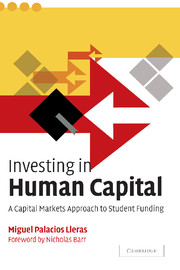Crossref Citations
This Book has been
cited by the following publications. This list is generated based on data provided by Crossref.
Asplund, Rita
Adbelkarim, Oussama Ben
and
Skalli, Ali
2008.
An equity perspective on access to, enrolment in and finance of tertiary education.
Education Economics,
Vol. 16,
Issue. 3,
p.
261.
Yang, Lijing
2011.
Higher Education in the Asia-Pacific.
Vol. 36,
Issue. ,
p.
77.
ECKWERT, BERNHARD
and
ZILCHA, ITZHAK
2012.
Private Investment in Higher Education: Comparing Alternative Funding Schemes.
Economica,
Vol. 79,
Issue. 313,
p.
76.
John, Edward P. St.
and
Meyer, Heinz-Dieter
2013.
Fairness in Access to Higher Education in a Global Perspective.
p.
289.
Floreani, Vincent Arthur
2014.
Fixing Europe's Youth Unemployment and Skills Mismatch, Can Public Financial Support to SMEs Be Effective? The Case of the European Commission and European Investment Bank Joint Initiatives.
SSRN Electronic Journal,
Berg, Gary A.
2014.
Social Business.
p.
63.
ECKWERT, BERNHARD
and
ZILCHA, ITZHAK
2014.
Higher Education: Subsidizing Tuition versus Subsidizing Student Loans.
Journal of Public Economic Theory,
Vol. 16,
Issue. 6,
p.
835.
Gary‐Bobo, Robert J.
and
Trannoy, Alain
2015.
Optimal student loans and graduate tax under moral hazard and adverse selection.
The RAND Journal of Economics,
Vol. 46,
Issue. 3,
p.
546.
Eckwert, Bernhard
and
Zilcha, Itzhak
2017.
Student loans: When is risk sharing desirable?.
International Journal of Economic Theory,
Vol. 13,
Issue. 2,
p.
217.
Panigrahi, Jinusha
2018.
Education Finance, Equality, and Equity.
Vol. 5,
Issue. ,
p.
113.
Caetano, Gregorio
Palacios, Miguel
and
Patrinos, Harry A.
2019.
Measuring Aversion to Debt: An Experiment Among Student Loan Candidates.
Journal of Family and Economic Issues,
Vol. 40,
Issue. 1,
p.
117.
Chankseliani, Maia
Gorgodze, Sophia
Janashia, Simon
and
Kurakbayev, Kairat
2020.
Rural disadvantage in the context of centralised university admissions: a multiple case study of Georgia and Kazakhstan.
Compare: A Journal of Comparative and International Education,
Vol. 50,
Issue. 7,
p.
995.
Garafiev, I. Z.
and
Garafieva, G. I.
2021.
Proceeding of the International Science and Technology Conference "FarEastСon 2020".
Vol. 227,
Issue. ,
p.
1237.
Schmal, Friederike
and
Trede, Mark Matthias
2023.
Hedging Potential of Occupational and Regional Wage Indices.
Journal of Income Distribution®,
Panigrahi, Jinusha
2023.
Financing of Higher Education.
p.
63.



